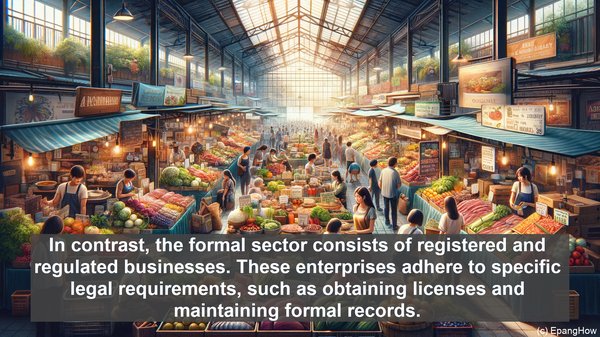Introduction: The Dual Nature of an Economy
Hello everyone! When we talk about an economy, we often refer to two distinct sectors: the informal sector and the formal sector. These sectors coexist, each with its unique characteristics and implications. Today, we’ll explore the differences between these two sectors, shedding light on their roles and significance.
Defining the Informal Sector: Flexibility and Informality
The informal sector primarily comprises unregistered or unincorporated enterprises. These businesses often operate on a small scale, employing a limited number of workers. What sets the informal sector apart is its flexibility. Here, employment arrangements are often informal, lacking written contracts or defined working hours. Additionally, the informal sector is characterized by low levels of regulation, with minimal government oversight.

Exploring the Formal Sector: Structure and Regulations
In contrast, the formal sector consists of registered and regulated businesses. These enterprises adhere to specific legal requirements, such as obtaining licenses and maintaining formal records. The formal sector often encompasses larger organizations, employing a significant workforce. Here, employment contracts are formal, with clearly defined terms and conditions. Moreover, the formal sector is subject to various regulations, ranging from labor laws to tax obligations.
Employment Dynamics: Quantity vs. Quality
One of the key distinctions between the two sectors lies in their employment dynamics. While the informal sector may provide a larger number of jobs, these positions often lack stability and social security benefits. In the formal sector, on the other hand, jobs are typically more secure, offering benefits such as health insurance, retirement plans, and paid leave. Consequently, the formal sector is often associated with higher income levels and better quality of life.
Economic Impact: Productivity and Taxation
Both sectors play a crucial role in an economy, albeit in different ways. The informal sector, with its flexibility, often serves as a source of livelihood for those who may not have access to formal employment. It contributes to the overall economic output, albeit to a lesser extent compared to the formal sector. The formal sector, on the other hand, tends to be more productive, benefiting from structured processes and access to resources. Moreover, the formal sector’s adherence to regulations ensures tax compliance, contributing to government revenue.

